
If the heart of Barcelona is the old city’s Gothic Quarter, known as Barri Gòtic in the local Catalan language, then the aorta must be La Rambla.
The life blood of the Catalonian capital flows through this boulevard, from the Plaça de Catalunya to the sea at Port Vell.
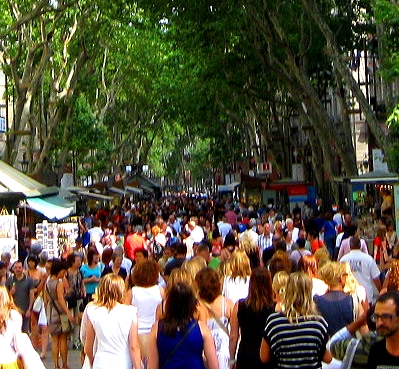
We set out to ramble down La Rambla. This tree lined pedestrian walkway is actually a series of streets and as such is more correctly referred to as Las Ramblas, but call it whatever it is still quite the show.
The stretch of streets has become one giant open air theater.
It is truly one of the world’s premier venues for street performers. Most do their schtick as human statues by painting themselves to look like metal or marble.
Many had some very impressive costumes and props, one even looked to be floating in mid-air.
WATCH: The amazing Human Statues of La Rambla
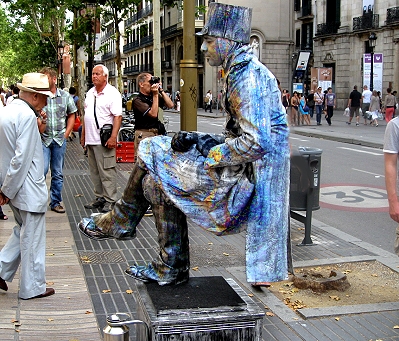
The idea is to attract enough attention to get a little donation. Then the frozen forms burst to startling life as soon as a coin hits their tip jar.
Squeals of laughter, glee, surprise and even some terrified screams filled the air along the avenue.
Not just anyone can paint up and try to hold perfectly still along La Rambla though. The performers must be OK’d by the Department of Commerce and Tourism and display a permit. It is actually a pretty serious business with the top talents earning hundreds of Euros a day.
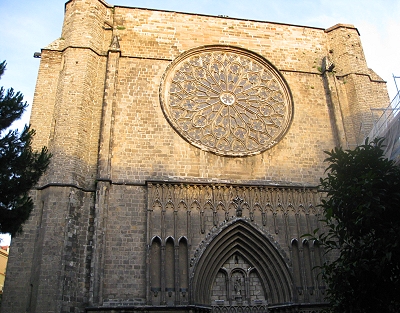
About half way along, and off to the side of the promenade, we took a small detour to check out the church of Santa Maria del Pi, which means St. Mary of the Pine Tree.
Depending on who we asked, the name refers to the legend that The Holy Family found shelter in a pine tree during their flight from Herod or simply that a pine tree used to stand out in front.
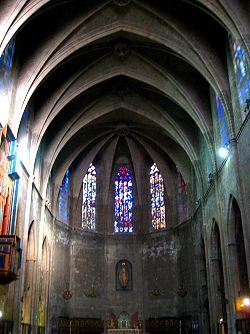
The church dates back to the 1300s and is a fine example of the Gothic style, but it is best known for the huge ornate rose window adorning the front facade.
Over thirty feet in diameter, it is quite a sight. Unfortunately it is not the original work, that was destroyed by a fire in 1936 set by anti Franco forces as the revolution was brewing.
The interior is so formidable, due to its bunker-like feel and heavy acoustics, we could feel its holiness bearing down on us, literally. It was quite a different feel from the lively spirit and music outside.
WATCH: Take a stroll though the Barri Gòtic
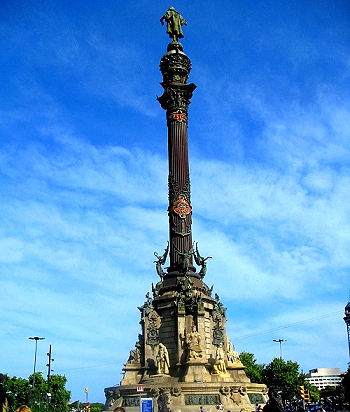
Bursting back out into the sunshine and fresh air, we snagged a gelato and headed to the end of the road where it meets the Mediterranean Sea at Port Vell.
The circle at the end of La Rambla is home to the famous Christopher Columbus Monument.
Built for the Exposición Universal de Barcelona in1888, it marks the spot where Columbus returned to Spain after his first voyage to the New World.
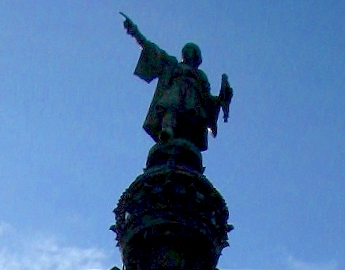
A statue of the confused explorer stands atop a pedestal nearly two hundred feet high. The Captain is striking a stoic pose with his outstretched arm toward The Mediterranean.
Myths have persisted through the years that he is pointing West toward the Americas of his discovery, or East toward his home of Genoa, Italy, but the fact is he is pointing South, for no better reason than that it looks good for him to be pointing out to sea.
As far as we know the statue is made of real bronze, not a painted person politely posing for pedestrians.
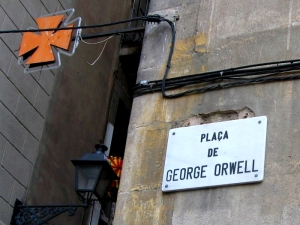
From beneath the bronze Christopher we headed into the heart of the Gothic Quarter.
Wandering through the narrow, ancient streets, we came upon a small square and noticed a sign with name Plaça de George Orwell.
We sat outside a cafe for a cool drink and some quick tapas, and asked our server why the square was named after the famed writer. He had no idea, so we were forced to go to Google.
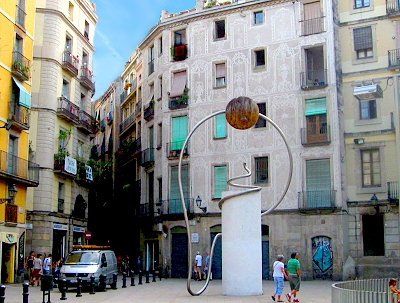
The renowned author came to Barcelona in 1936 to fight in The Spanish Revolution, saying he had “come to Spain to join the militia to fight against Fascism.”
He was wounded in battle the next year and then wrote the book Homage to Catalonia about his experiences and the corruption and tyranny of Soviet communism that he had discovered during his service. And, yes, there were quite a few “security” cameras in George Orwell Plaza. A little Big Brother irony, no?
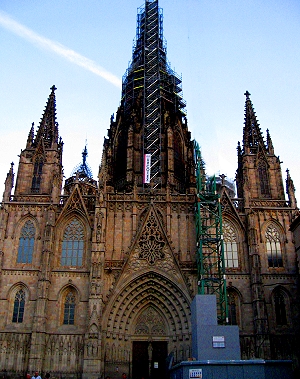
As we walked further away from the sea we came upon the Plaça Nova which is dominated by the Catedral de la Santa Creu i Santa Eulàlia, or Cathedral of the Holy Cross and Saint Eulalia. This is actually the seat of the bishop and main church of Barcelona, not Guadi’s masterpiece Sagrada Familia.
Makes sense since there has been a church on this spot basically ever since there has been such a thing as Christian churches.
The current version is about 700 years old and is about as Gothic as it gets, an impressive mass of spires, towers, arches, flying buttresses and gargoyles.
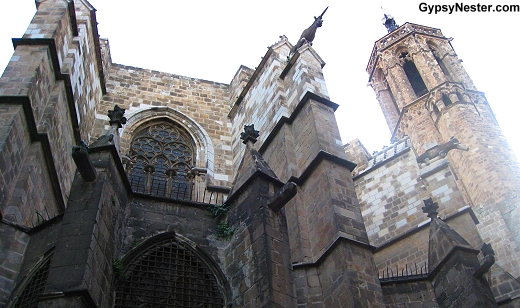
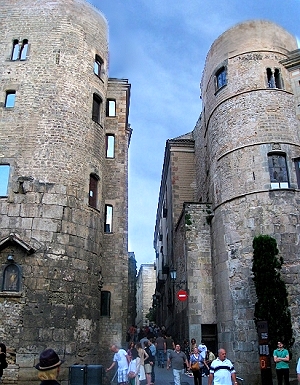
The original church dates back to the year 343 when Barcelona was a Roman enclave called Barcino. The legend is that the Carthaginian Hamilcar Barca, father of Hannibal, named the city Barcino after his family in the 3rd century BC.
History says that by about 15 BC the Romans had established a castrum or military camp here. As we looked around the plaza, we began to notice that remnants of the Roman city remain.
This was once the spot where the main gate opened through the city’s walls. The remains of that Roman gateway and an aqueduct have been incorporated into the medieval Portal del Bisbe that leads back into the Gothic Quarter.
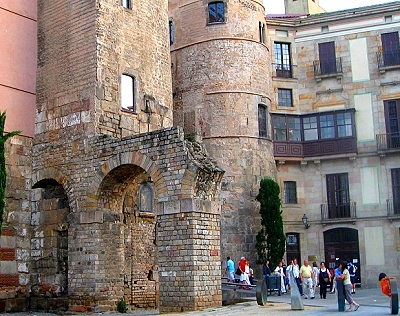
Through the passage and behind the cathedral there are a few bits and pieces left of the Roman Forum and, tucked into a courtyard, four columns from the Temple of Augustus.
With the sun sinking low and many miles of ancient cobblestones under our feet, we were ready to call it a day, all in all a great day. But wait, by Barcelona standards it wasn’t near dinner time, surely we could manage one more quick stop for some tapas before we found a subway stop.
Of course we could, and don’t call me Shirley.
David & Veronica, GypsyNester.com
Delve Deeper into Barcelona:
Sagrada Familia
Eating Tapas
Gaudí or Gaudy – You Decide



Love this area of Barcelona. The human statues on Las Ramblas are pretty entertaining.
Catalan is a recognized language, not a dialect. Saying it’s a dialect diminishes the culture, something the Catalans have been fighting long odds to preserve for centuries. Thank you.
Thanks for pointing that out Larry. We have changed it.
People told us to avoid La Rambla because it’s too touristy and there are a lot of pick-pockets, but we loved it! The buskers were amazing and we had so much fun watching all of them.
It definitely is crowded and touristy, but sometimes that’s fun. We loved it too.
Every single thing you write about makes me want to travel! Love this!
Thanks!
Isn’t there a replica of one of Christopher Columbus’s ships in the harbor? I seem to remember that they have a replica of the Santa Maria there. Very small and scary to go out on the ocean in that!
We didn’t see a replica but you’re right, his boats were scary small.
I love the Christopher Columbus monument. It struck me the first time I saw it that he was as revered back in Europe as he was in the New World, something I never really considered before.